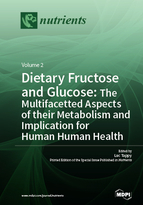Dietary Fructose and Glucose: The Multifacetted Aspects of their Metabolism and Implication for Human Health
A special issue of Nutrients (ISSN 2072-6643).
Deadline for manuscript submissions: closed (28 February 2017) | Viewed by 479991
Special Issue Editor
Interests: metabolism of sugars at rest and during exercise; role of fructose in the pathogenesis of metabolic diseases
Special Issues, Collections and Topics in MDPI journals
Special Issue Information
Dear Colleagues,
We welcome the submission of manuscripts, either describing original research, or reviewing scientific literature. Manuscripts should focus on well-defined topics not previously reported extensively in the literature, such as (but not limited to):
- functional aspects of fructose and glucose metabolism
- health effects of chronic fructose consumption
- molecular and mechanistic insights of hexoses-induced adaptations
- sugars, sweet taste receptors and brain responses
- intervention studies in humans
Papers covering species comparisons of nutrition/metabolism or evolutionary perspectives, or effects of fructose and glucose in specific physiological conditions (physical activity, pregnancy, growth, etc.) or special tissues (testis, placenta) are welcome.
Prof. Luc Tappy
Guest Editor
Manuscript Submission Information
Manuscripts should be submitted online at www.mdpi.com by registering and logging in to this website. Once you are registered, click here to go to the submission form. Manuscripts can be submitted until the deadline. All submissions that pass pre-check are peer-reviewed. Accepted papers will be published continuously in the journal (as soon as accepted) and will be listed together on the special issue website. Research articles, review articles as well as short communications are invited. For planned papers, a title and short abstract (about 100 words) can be sent to the Editorial Office for announcement on this website.
Submitted manuscripts should not have been published previously, nor be under consideration for publication elsewhere (except conference proceedings papers). All manuscripts are thoroughly refereed through a single-blind peer-review process. A guide for authors and other relevant information for submission of manuscripts is available on the Instructions for Authors page. Nutrients is an international peer-reviewed open access semimonthly journal published by MDPI.
Please visit the Instructions for Authors page before submitting a manuscript. The Article Processing Charge (APC) for publication in this open access journal is 2900 CHF (Swiss Francs). Submitted papers should be well formatted and use good English. Authors may use MDPI's English editing service prior to publication or during author revisions.
Keywords
- fructose
- added sugars
- metabolic syndrome
- glucose production
- intrahepatic lipids
- intramyocellular lipids
- uric acid
- food intake
- satiety
- exercise
- energy efficiency







